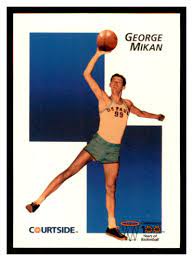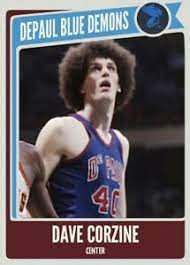CLICK HERE for today’s NEWS, NOTES, AND HIGHLIGHTED GAMES
CLICK HERE for the latest HOOPS HD REPORT Video Podcast
When your nickname is “Mr. Basketball” you better have the resume to back it up…and George Mikan certainly did. At DePaul he practiced his hook shots with both hands so much that it became known as “The Mikan Drill”. He was a 3-time All-American, 2-time national POY, and led the Blue Demons to the 1945 NIT title en route to being named NIT MVP. After graduating in 1946 he played in the NBL/BAA/NBA and won 7 titles in 8 years from 1947-1954. He was so dominant that the NBA widened the lane from 6′ to 12′ (aka “The Mikan Rule”). In 1967 he was named the 1st commissioner of the ABA and instituted the 3-PT line. Mikan passed away in 2005 but HoopsHD’s Jon Teitel got to chat with Mikan’s fellow DePaul All-American Dave Corzine about the man voted Greatest Player of the 1st Half-Century. Today marks the 72nd anniversary of Mikan playing in the lowest-scoring game in NBA history (19-18) on November 22, 1950, so we take this time to remember his life/legacy.
Mikan learned how to use his size in the paint by making hook shots with either hand: how did he and Coach Ray Meyer come up with “The Mikan Drill”, and did you learn it yourself when 1st learning the sport? I do not think that I started practicing it until I got to DePaul where I learned it from Coach Meyer himself.
Hall of Famer Rick Barry was well known for shooting FTs underhanded but Mikan used that technique as well: what made it so effective, and can we assume that nobody laughed at him because he was bigger than everyone else?! Rick swears by it and George was a pretty good free throw shooter as well so I guess that it works, although I never tried it much myself. Rick says that it is a better angle to shoot from: the ball has a better spin and you have better control when releasing the ball with two hands. However, Rick could not even get his own sons to try it!
He led the nation in scoring for 2 years in a row (1945/1946) and was named 1945 NIT MVP after leading DePaul to the title by scoring 120 PTS in 3 games (including 53 PTS in a 97–53 win over Rhode Island where he equaled the score of the entire Rams team!): what made him such a sensational scorer? He was physically dominant and very aggressive. Plus: practice, practice, practice.
He finished his college career as a 2-time national POY/3-time All-American: where does he rank among the greatest players in the history of college basketball? It is hard to rank players from different eras but he is obviously one of the most dominant players in college basketball history. Out of sight, out of mind: recent players always get more recognition.
He completed his first season with the Minneapolis Lakers in 1948 by leading the NBL in scoring/being named MVP/winning the title: how was he able to make such a smooth transition from college to the pros? Just as great players do today, it is a matter of having the physical/mental capabilities to succeed…and he obviously had them.
On November 22, 1950 he participated in 1 of the most notorious NBA games ever played (after Fort Wayne took a 19-18 lead in the 4th quarter they became worried that Mikan would beat them singlehandedly [he scored 15 of his team’s 18 PTS to set an NBA all-time record with 83.3% of his team’s offense] so the Pistons simply passed the ball around without trying to make a basket and won the lowest-scoring NBA game of all time): how did he feel about the outcome of the game, and did he take any pride in the fact that the league had to invent the shot-clock specifically because of his superb skills? I would bet that he was actually pissed about the new rules because they were implemented specifically to limit his own success.
His terrific talent also caused the league to institute some other rule changes including making goaltending illegal and widening the foul lane from 6’ to 12’ (aka “The Mikan Rule”): do you think that when Dr. James Naismith came up with the original rules for basketball he simply could not have envisioned anyone with Mikan’s size being able to dominate the sport? I do. It was just a game he made up for his gym class so I doubt that he could have been that far-sighted.
In January of 1952 he scored a career-high 61 PTS and set an NBA record with 36 REB in a 10-PT 2-OT win over Rochester: where does that rank among the greatest basketball performances that you have ever heard of? There was Wilt’s 100-PT game and I have been around for some of Michael Jordan’s/Kobe Bryant’s great games. I actually scored 8 PTS in the 1986 playoff game where Michael scored 63 PTS in Boston. George’s game is among the best but I am unable to rank them.
He sustained 10 broken bones/16 stitches during his career, often having to play through his injuries despite the limited medical care available in the 1950s: how crucial was his toughness to his success? Toughness is always crucial to success. 16 stitches does not seem like that much…but I would love to hear how he managed to break 10 bones! Back then I think that many guys just played with those kinds of injuries. I heard that they taped a metal plate to his leg after he shattered the bone and he somehow played with the plate during the playoffs.
He was inducted into the Hall of Fame in 1959, named 1 of the NBA’s 50 Greatest Players ever in 1996, and passed away in 2005 after a long battle with diabetes: when people look back on his career, how do you think that he should be remembered the most? As one of the most dominant players of any era in both college/pro basketball.


